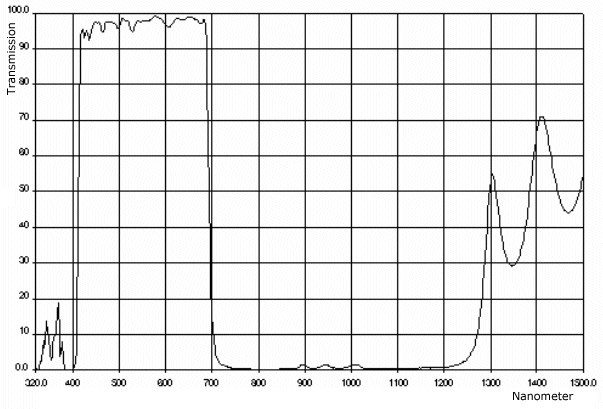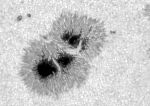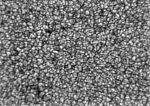Distribution
![]() News
News
![]() Notes & Interesting Articles
Notes & Interesting Articles
![]() Overview
Overview
![]() Pricing
Pricing
![]() Products
Products
Accessories and Options
![]() Filters
Filters
![]()

Baader Planetarium UV/IR Cut Filter

Right: Baader 2 inch UV / IR Cut Filter P/N BPUVIR2 shown as provided with plastic case and box.
This filter is also available in 1.25 inch diameter shown lower left on this page (70,432 bytes).
Click on image for enlarged view (144.945 bytes).
-
Filters take away but they can not add - diminishing some parts of the spectrum
so that we might resolve what is otherwise obscured...
How Are These Constructed?
The filter is made with a disc of transparent optical glass that has been ground plane parallel to within thirty seconds of arc, and then polished until very smooth. The glass undergoes a vacuum deposition coating process where numerous micron-thin coatings of various elements are applied one upon another in a precise order and thicknesses. The coatings are calculated to transmit desired wavelengths (portions of the visible spectrum), while simultaneously rejecting other wavelengths.
When looking through this filter while holding it parallel to the human eye the filter element appears completely transparent. When tilted, depending on the angle of tilt and lighting, it will then appear to have a greenish or magenta toned antireflection coating.
Left: Baader 1.25 inch UV / IR Cut filter (15,963 bytes).
The Baader UV / IR Cut filter is made available in diameters of 1.25 (31.7 mm) and 2 inch (50.8 mm) so that it can be installed in line onto many accessories, or directly onto most popular eyepieces.
What Does This Do For Me?
Protect sensitive equipment from heating during solar applications.
Stays cool and will not shatter if subjected to great thermal stress, since even intensive radiation is not absorbed as with ordinary "heat protective Filters" such as KG-3 or KG-5. Energy is reflected due to an elaborate interference system of twenty three dielectric coating layers.
For for daytime or astronomical digital or film imaging it improves the quality of star images.
Because of it's high ninety eight percent average transmission across the visible spectrum, this filter can be used with with any size or design of amateur telescope with no perceptible loss of brightness.
Features Of The Baader Filter:
Examples of Imaging with the UV / IR Filter:
Consider the following three picture which were taken by Mr. Oliver Grattepanche. He explains the instrument and accessories employed:
Above Left to Right: Sunspot taken with VestaPro with 1/3 inch diagonal black and white CCD sensor,
The optional wood case is foam lined with cutaway spaces for filters, eyepieces and other small accessories for your telescope. Please refer to our price list for current prices for the filter set and the optional case or contact Company Seven for more information.
Right: optional wood box for Color Filter Set (52,803 bytes)
 Right: Baader UV / IR filter transmission curves. Notice how little effect it has in the visual spectrum of 400 to 700 nm, while blocking the UV and IR light (132,179 bytes).
Right: Baader UV / IR filter transmission curves. Notice how little effect it has in the visual spectrum of 400 to 700 nm, while blocking the UV and IR light (132,179 bytes).
"TSC 225 Schmidt Cassegrain from TAKAHASHI, NJP160 mount, F/40 with 2X Big Barlow TeleVue, NGFs more focuser, and OF course your incredible Baader astro+solarly filter D:3.8, IR CUT filter and Continuum filter".



Surface granulation shown with 800 CCD frames stacked with IRIS astronomical images processing software.
The colors were added afterward basic image compiling and processing for aesthetic purposes.
Click on images to see enlarged view
Click on the image to see enlarged view (190,049 bytes).
FURTHER READING
CLEANING & MAINTENANCE INSTRUCTIONS:
![]() Baader Planetarium UV-IR Cut Filter one page color illustrated overview of the filter. Includes filter transmission curve graphs for the filter alone, and when combined with the Baader Contrast Booster filter too. Publication content by Baader Planetarium, all rights reserved. From Company Seven's Archives (208,907 bytes in Adobe .pdf).
Baader Planetarium UV-IR Cut Filter one page color illustrated overview of the filter. Includes filter transmission curve graphs for the filter alone, and when combined with the Baader Contrast Booster filter too. Publication content by Baader Planetarium, all rights reserved. From Company Seven's Archives (208,907 bytes in Adobe .pdf).
![]() Baader Planetarium Professional Astronomical Filters one page color illustrated overview of several Baader specialized astronomical filters including the UV / IR, the Solar Continuum Narrow Band, Contrast Booster, Color Filter Set,
Baader Planetarium Professional Astronomical Filters one page color illustrated overview of several Baader specialized astronomical filters including the UV / IR, the Solar Continuum Narrow Band, Contrast Booster, Color Filter Set,
Contents Copyright 1999-2006 Company Seven All Rights Reserved

